
Arezzo is a city and comune in Italy and the capital of the province of the same name located in Tuscany. Arezzo is about 80 kilometres southeast of Florence at an elevation of 296 metres (971 ft) above sea level. In 2013 the population was about 99,000.
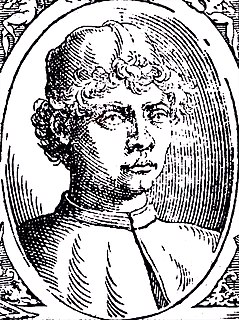
Piero della Francesca, originally named Piero di Benedetto, was an Italian painter of the Early Renaissance. To contemporaries he was also known as a mathematician and geometer. Nowadays Piero della Francesca is chiefly appreciated for his art. His painting is characterized by its serene humanism, its use of geometric forms and perspective. His most famous work is the cycle of frescoes The History of the True Cross in the church of San Francesco in the Tuscan town of Arezzo.
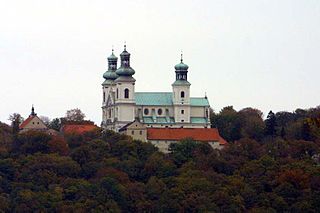
The Camaldolese monks and nuns are two different, but related, monastic communities that trace their lineage to the monastic movement begun by Saint Romuald.
The Church of the Holy Sepulchre is a church in the Christian Quarter of the Old City of Jerusalem, believed to be the site of Jesus's empty tomb.

Nonantola Abbey, dedicated to Saint Sylvester, is a former a Benedictine monastery and prelature nullius in the commune of Nonantola, c. 10 km north-east of Modena, in the Emilia Romagna region of Italy. The abbey church remains as a basilica and is the co-cathedral of the diocese of Modena-Nonantola.

Sansepolcro, formerly Borgo Santo Sepolcro, is a town and comune founded in the 11th century, located in the Italian Province of Arezzo in the eastern part of the region of Tuscany.
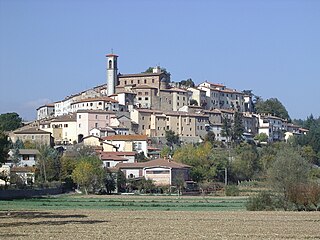
Monterchi is a Comune (Municipality) in the Province of Arezzo in the Italian region of Tuscany, located about 80 kilometres (50 mi) southeast of Florence and about 20 kilometres (12 mi) east of Arezzo. It sits in the northern part of Valtiberina, the valley where the Tiber river runs going from Emilia-Romagna towards Rome. The valley runs through Romagna, Tuscany and Umbria, parallel to the Casentino Valley.

The Roman Catholic diocese of Sansepolcro was a Latin rite see in Tuscany, central Italy. It was erected in 1515, as the Diocese of (Borgo) Sansepolcro (Italian), though difficulties prevented the appointment of a bishop until 1520. On 30 September 1986, the diocese was suppressed and united with the Diocese of Arezzo and the Diocese of Cortona to form the Diocese of Arezzo-Cortona-Sansepolcro.

A Madonna del Parto is an iconic depiction of the Virgin Mary shown as pregnant, which was developed in Italy, mainly in Tuscany in the 14th century. Examples include works by Taddeo Gaddi, Bernardo Daddi and Nardo di Cione, but the fresco by Piero della Francesca is considered the most famous one. The Madonna was portrayed standing, alone, often with a closed book on her belly, an allusion to the Incarnate Word. The works were associated with the devotions of pregnant women, praying for a safe delivery. Sometimes, as with a statue by Sansovino in the Basilica of Sant'Agostino in Rome, the depiction is of a Virgin and Child, but known as a Madonna del Parto because it was especially associated with devotions over pregnancy. Here the Virgin wears the Girdle of Thomas, a belt of knotted cloth cord that was a relic held in Prato Cathedral, which many depictions wear.

The Baptism of Christ is a painting by the Italian Renaissance master Piero della Francesca. Painted in egg tempera on two panels of poplar wood, the dating is controversial – some give it a very early date, perhaps 1439; others much later, around 1460. It is held by the National Gallery, London.

Bartolomeo della Gatta (1448–1502), born Pietro di Antonio Dei, was an Italian (Florentine) painter, illuminator, and architect. He was the son of a goldsmith. He was a colleague of Fra Bartolommeo. In 1468, Bartolomeo became a monk in the Order of Camaldoli, which his brother Nicolo had already entered. Upon taking holy orders, he changed his name to Bartolomeo. About 1481, he was summoned to Rome where he contributed to the cycle of frescos on the walls of the Sistine Chapel. He collaborated with Luca Signorelli. Bartolomeo eventually became Abbot of San Clemente in Arezzo. He died in 1502 and was buried in the Abbey of San Clemente.

The diocese of Cortona was a Roman Catholic ecclesiastical territory in central Italy, which existed from 1325 to 1986. It was immediately subject to the Holy See.

The Italian Catholic diocese of Arezzo-Cortona-Sansepolcro has existed since 1983. In that year the historic diocese of Arezzo was combined with the diocese of Cortona and the diocese of Sansepolcro, the enlarged diocese being suffragan of the archdiocese of Florence.

Arezzo Cathedral is a Roman Catholic cathedral in the city of Arezzo in Tuscany, Italy. It is located on the site of a pre-existing Palaeo-Christian church and, perhaps, of the ancient city's acropolis.
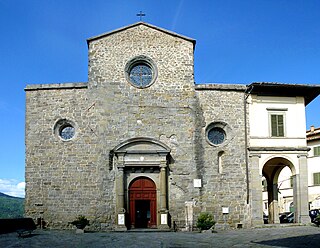
Cortona Cathedral is a Roman Catholic cathedral in Cortona, Tuscany, central Italy, dedicated to the Assumption of the Blessed Virgin Mary. It was the seat of the Bishops of Cortona from 1507 to 1986, and is now a co-cathedral in the present Diocese of Arezzo-Cortona-Sansepolcro.

The Badia delle Sante Flora e Lucilla or Abbey of Saints Flora e Lucilla is a Medieval abbey in Arezzo, Tuscany, Italy.

The Museo Civico di Sansepolcro or Museo Comunale is the town or comune art gallery. It is housed in a series of linked palaces, including the medieval former Palazzo della Residenza, the Palazzo dei Conservatori del Popolo and the Palazzo del Capitano o Pretorio, located on Via Niccolò Aggiunti #65, near the center of Sansepolcro, formerly Borgo Santo Sepolcro, in the Province of Arezzo, region of Tuscany, Italy. The museum was founded in 1975.
Galeotto Graziani, O.Cam., was an Italian monk of the Camaldolese Order and Roman Catholic prelate who served as the first Bishop of Sansepolcro (1520–1522).
The Diocesan museum of sacred art in Arezzo was founded in 1963 but opened regularly to the public only in 1985, and was housed in several rooms above the sacristy of the Cathedral of San Donato. In 2011 it was relocated to the first floor of the bishop's residence. The museum exhibits works of art and liturgical items, from the 12th to the 19th centuries, that come from the cathedral and other churches in the diocesan territory, significant for their religious and cultural significance to Arezzo and the surrounding area. Highlights of the museum include several works of Giorgio Vasari and the Pace di Siena.
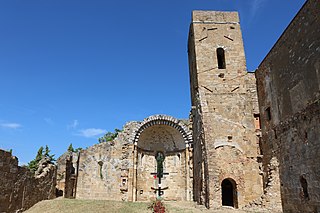
The Abbey of the Holy Savior and of Sts. Justin and Clement, also known as the Camaldolese Abbey of St. Justin, is a former Italian monastery in the city of Volterra, Pisa, which was founded in the 11th century. It was a major religious institution of the region until it was initially abandoned by the monks due to earthquake damage in the 19th century and then taken over and dissolved under the Risorgimento movement for the political unification of the Italian peninsula. For most of its history, it operated as a monastery of Camaldolese monks.


















